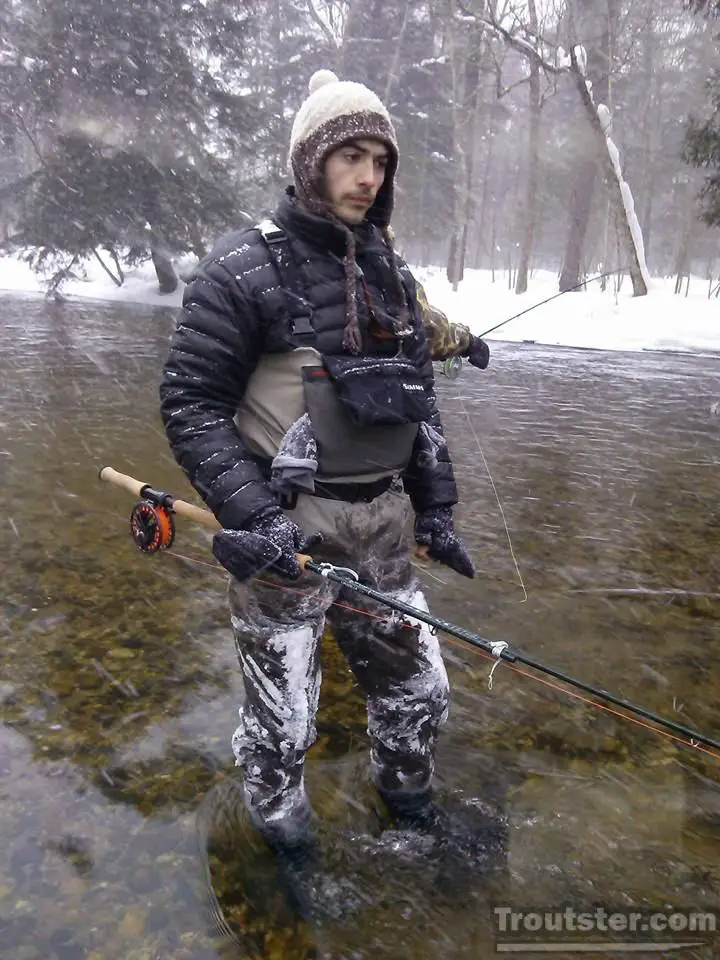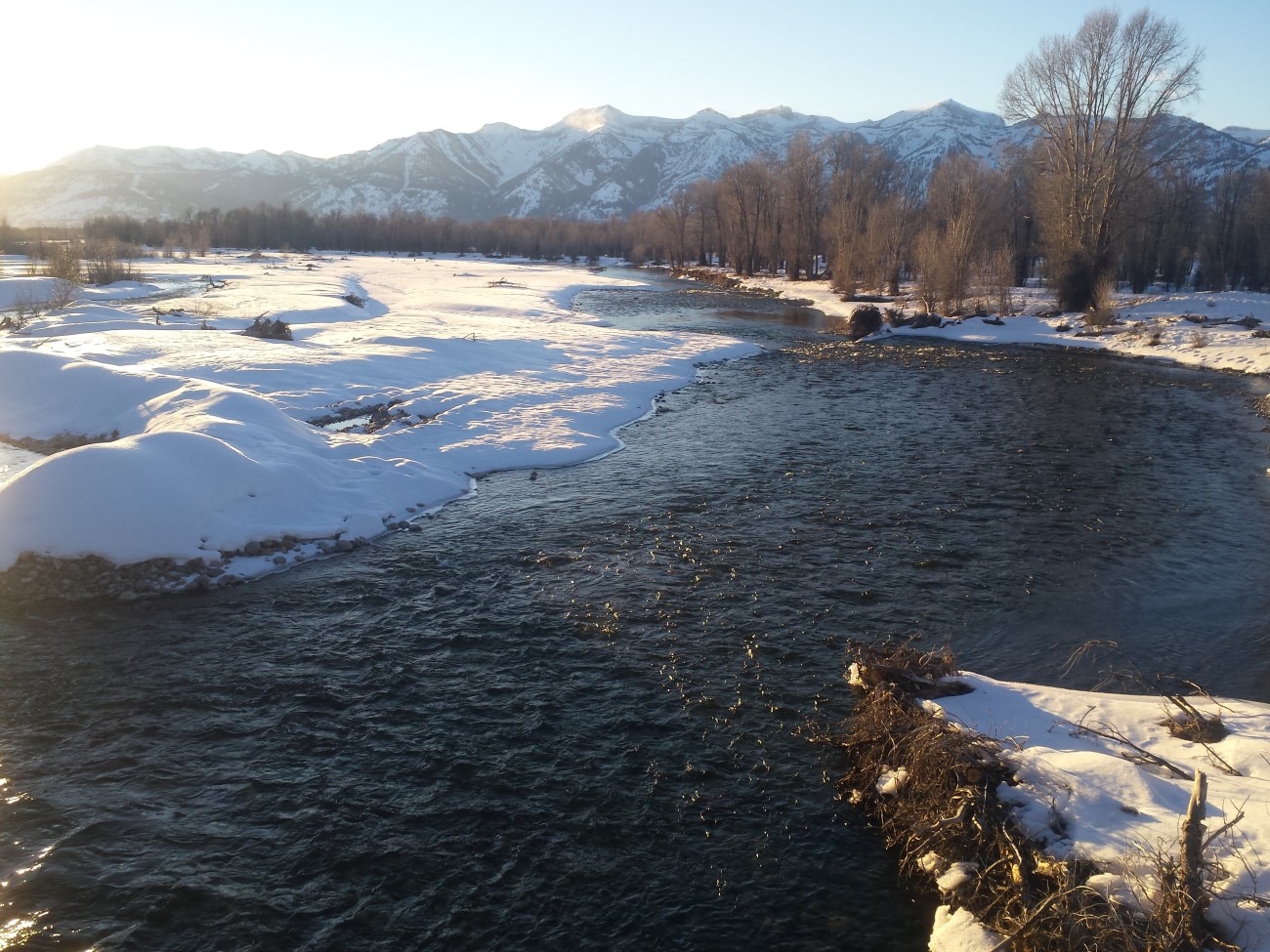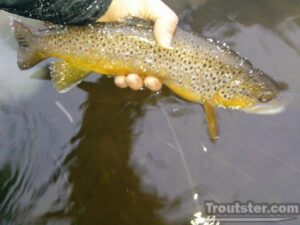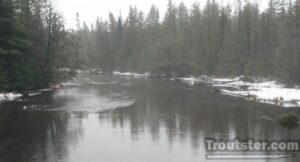This post was last updated on February 11th, 2023 at 04:23 pm

Catching Trout in the Winter-
Fall comes to an abrupt end leaving you with an unfulfilled feeling in your gut of having not caught nearly enough fish during the warm months. Perhaps it’s late winter and you are getting spring fever?
Maybe you are just dying to try out that new fly fishing rod you got for Christmas. Whatever the case, winter is a great time to catch fish! Follow these tips to a successful winter trout or fly fishing trip.
Prepare Yourself with the Proper Attire
I thought about getting right to the fishing aspect of this post, but keeping warm is very important. If you get cold your fun is over, so you will likely not hook any fish. Wearing waders is obviously going to be mandatory this time of year, but knowing what to wear underneath is more important.
If you aren’t floating in a drift boat, you might have to do a lot of hiking on the side of the river. With this in mind you should consider wearing moisture wicking under layers. If you are wearing cotton below the waders and work up a sweat, you could be in trouble.
The layers closest to your skin should be working to pull any moisture away from your body. This will ensure you stay warm and dry allowing you to concentrate on what’s important, hooking fish.
Items that will keep you dry and extras you should include on your trip:
- Wool socks or polypropylene sock liners. (Wool is one of the only natural materials known to continue to insulate after becoming wet.)
- Polypropylene or similar wicking thermal underwear
- Wool finger-less gloves, with a fold over mitten part
- A full set of extra clothes
- Some items to start a fire quickly, such as a lighter and dry tinder of sorts. ( a heater if you are in a boat)
Tips to Catch Trout in the Extreme Winter Cold
Trout are not warm blooded as we all know, so with cold water comes sluggish fish and small appetites. A trout feeding in the middle of summer will be burning large amounts of calories just maintaining its position in a riffle. Sort of an easy come easy go deal.
There are endless amounts of foods for fish all summer long, so they don’t mind burning calories and eating aggressively. During the winter they burn very few calories and will move very little, these fish are about one step away from hibernation in extremely cold water. They won’t chase your flies and they wont eat big flies presented with sub par drifts.
Finding the Fish in Winter

Slow Water
Trout can reliably be found in slower water this time of year. I don’t mean stagnant pools, you probably wont find fish there, but areas with very little current. Fish will rarely be found in riffles or other areas where you might find them feeding in the summer. They are lethargic and survival is the trout’s goal, feeding is not usually the top priority for them in the winter. A deep slow steady current on the outside of a bend or in the middle of the river should hold the most fish.
Depth and Cover
Look for areas that are more than a couple feet to hold the highest numbers of fish. Trout are sluggish and they know it. Evolution has honed them to the species they are today with natural instincts to keep them safe. Natural selection has removed most fish from the gene pool that sit visible in shallow water while their cold water response time is so slow.

Trout will often seek the cover of logjams and overhanging trees in deep water. These fish will often be difficult to catch for obvious reasons. Personally I would avoid making too many tight casts to these areas to save your fly supplies. The odds of a fish moving more than a few feet to eat your fly is slim anyway, fish the higher percentage areas with easy drifting.
Winter Trout Strategies
Whatever method you use you will need to keep in mind the state of these fish. They are not likely to move more than a foot to eat your flies. Perhaps the best winter trout fishing tip I can offer, is to be persistent and methodical about fishing each likely area. Incremental drifting from close to far (combing) covering every part of a good looking hole should yield the best results.
Here’s an informative article detailing 46 winter fly fishing tips.
Nymph Fishing in Winter
Nymphing will be the most productive way to catch trout this time of year, so line em up! Using a double or triple nymph rig below a strike indicator will be best. You should consider toning down the size of your flies and using light fluorocarbon tippets as well. The crystal clear color of a low trout stream will require you to drop the size of your tippets at least a size smaller than you would use in the summer.
Most of the winter insect activity will include midges and blue-winged olives. Size 18-22 are pretty standard this time of year and fish will often ignore anything larger.
Slow Down Your Streamer Presentation
 This applies only to streamer fishing, because your nymph strategy should be drifting with the existing current. Slow stripping streamers is an effective way to hook the big boys this time of year. Some of the largest trout I have seen caught were mid winter on smaller streamers. By slow stripping I mean really slow, like 1 foot per second or slower. This technique works, but it is not usually fast and furious action.
This applies only to streamer fishing, because your nymph strategy should be drifting with the existing current. Slow stripping streamers is an effective way to hook the big boys this time of year. Some of the largest trout I have seen caught were mid winter on smaller streamers. By slow stripping I mean really slow, like 1 foot per second or slower. This technique works, but it is not usually fast and furious action.
Winter is a great time to enjoy your favorite trout streams all to yourself. What would normally be a crowded fishing area in the summer will rarely see traffic in the cold of winter. You don’t have to sit around tying flies all winter, get out there and hook those fish!
